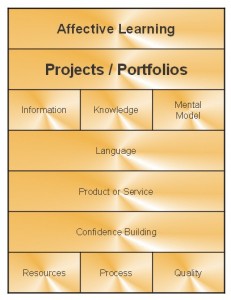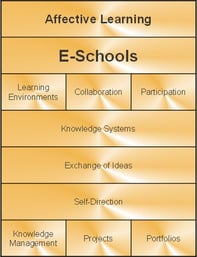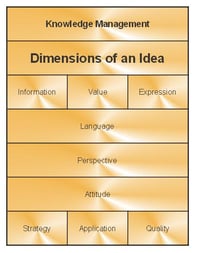Published on
Affective Learning Projects

Affective learning e-schools are built with standard software tools such as Microsoft Office and focus on structures and processes that organize information to reflect the way our brains organize and process knowledge. E-learning platforms use technology to share resources. They don’t enable learning.
E-schools are structured assemblies of affective learning projects. The collection of learning materials used to conduct and support each project is called a portfolio. Educators can build projects for teaching, students can build projects for learning, or they can work together collaboratively. Projects can be on any subject from a manufacturing process to learning a language and can be worked on individually or in groups. Affective learning projects always have the same structure and process. This provides an important consistency for sharing knowledge. Anyone can build a project. Affective learning projects enable everyone to demystify information by focusing on consistent organization and searching the Internet with purpose. There are nine steps in developing affective learning projects. A file is created for each project and documents and reference links are kept in the file. The documents and reference links can then be linked to the project main page which is based on the template in this article.
Information
Identify what you want to learn or teach and locate some appropriate information resources that will provide a basic understanding of it. Continue to add preferred references as they are identified. Free resources may be available on the Internet. Sometimes resources have to be purchased. Sometimes live contacts and discussion blogs can be considered resources. Also, an online course can be considered as a resource.
Knowledge
Ask questions as an educator or as a learner. Write records of the questions and answers that enhance your understanding or facilitate teaching. Add them to your file.
Mental Models
We learn things by creating mental models. Mental models are ideas. They can be expressed as artistic creations, recreational activities as well as designs for products and services. They are conceptual plans that we make for ourselves. They can be represented verbally or graphically or a as combination of both. Sometimes a mental model of a project is sub-divided into smaller projects for management reasons.
All new learning requires new language. This includes new terminology and contexts for using the terminology. Language may be a major factor in a project or it may not be. If it is, then some documentation should be developed or identified and added to the resource file.
Product or Service
Describe the product or service that will result by doing the project. This is the manifestation of the mental model. We may develop a mental model of a product or service, but the actual product or service will have much more precise detail than the general concept. Detailed plans are added to the resource file.
Confidence Building
How many products would be produced before the skill is fully developed? It depends on the individual doing the project. But the developmental process is always incremental. So the plan to move ahead should recognize this and the increments should be planned with lots of room for trial and error. A series of products or services ranging from simple to complex should be planned and the plan added to the resource file.
Resources
Projects require resources which will include facilities, tools and materials. If e-schools are being used in a conventional school setting, of if we are using e-schools in the workplace or community, resources are provided. If we are using e-schools for personal learning, we have to provide our own resources. Resource lists should be compiled and added to the resource file.
Process
Processes and procedures are the steps in producing the product or providing the service. Those procedures can be found in instructional manuals for most products and services and can be modified to suit individual requirements. They can also be developed. Documentation and reference links are added to the resource file.
Quality
The quality of the product or service should be documented for each attempt, ideas for improvements listed and added to the resource file. It is a process of continuous improvement that leads to being proficient from a certification standard and from a personal standard.
Projects may be stand-alone learning experiences. They may be organized into courses for credit purposes. Bigger projects would have more than one credit; smaller projects would have partial credit. Projects can also be organized into specializations (occupations, professions and disciplines). For example, projects could be developed for the welding occupation, for a civil engineering program, for algebra, for physics, or for a training program for writing.
Author Perspective: Business




